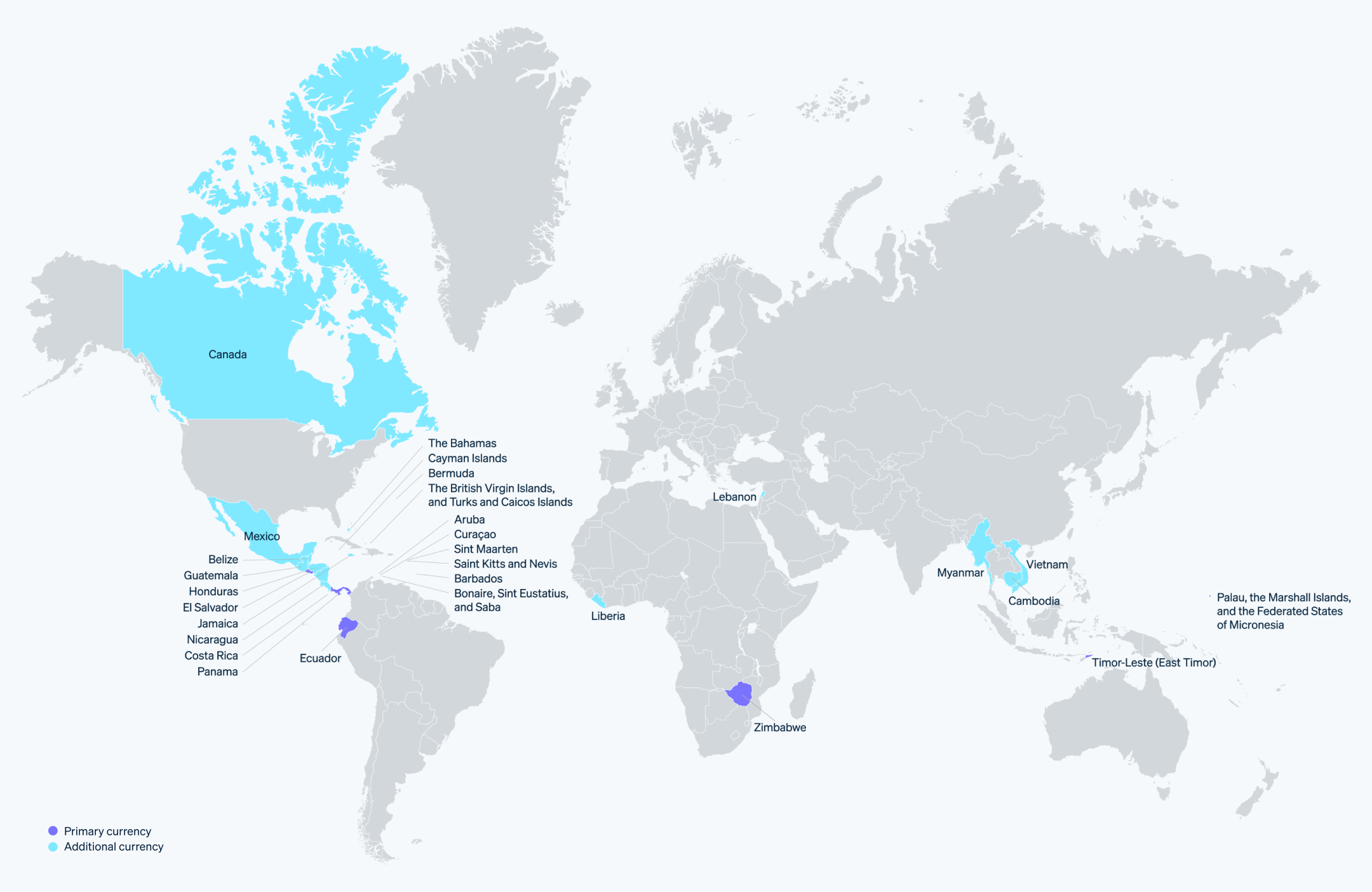ดอลลาร์สหรัฐ ซึ่งโดยทั่วไปจะถือว่าเป็นสกุลเงินสํารองชั้นนําของโลก มีอิทธิพลอย่างมากต่อการเงินและการค้าทั่วโลก กองทุนการเงินระหว่างประเทศรายงานว่าดอลลาร์สหรัฐคิดเป็นเงินสำรองการแลกเปลี่ยนเงินตราต่างประเทศทั่วโลก 59% ซึ่งจัดเก็บโดยธนาคารกลางในไตรมาสที่ 3 ของปี 2023 ซึ่งคิดเป็นเกือบ 6.5 ล้านล้านดอลลาร์และเกินสัดส่วนของยูโร (19.5%) และเงินเยนของญี่ปุ่น (5.5%) ไปมาก
สถานะของเงินดอลลาร์สหรัฐเป็นผลมาจากปัจจัยต่างๆ ซึ่งรวมถึงความแข็งแกร่งทางเศรษฐกิจและเสถียรภาพของสหรัฐฯ สภาพคล่องและความลึกของตลาดการเงิน รวมถึงความน่าเชื่อถือของกรอบกฎหมายและสถาบัน ปัจจัยเหล่านี้ทำให้ดอลลาร์สหรัฐเป็นที่ที่ปลอดภัยในช่วงที่ตลาดมีความปั่นป่วนและดึงดูดนักลงทุนต่างประเทศ ซึ่งสร้างความต้องการสําหรับสินทรัพย์ที่แปลงสกุลเงินดอลลาร์
การขึ้นไปมีสถานะเป็นสกุลเงินของวงเงินสำรองทั่วโลกของเงินดอลลาร์ทั่วโลกเริ่มขึ้นจากข้อตกลง Bretton Woods ในปี 1944 ซึ่งตรึงเงินดอลลาร์สหรัฐกับทองและตรึงสกุลเงินอื่นๆ กับเงินดอลลาร์สหรัฐ ทำให้ดอลลาร์สหรัฐเป็นสกุลเงินเดียวที่แปลงเป็นทองได้โดยตรง แม้ว่ามาตรฐานทองคำจะสิ้นสุดลงในปี 1971 แต่แรงขับเคลื่อนของดอลลาร์ยังคงดําเนินต่อไป ซึ่งเกิดจากความยืดหยุ่นที่ต่อเนื่องของเศรษฐกิจอเมริกันและการไม่มีทางเลือกอื่นที่เหมาะสม
แม้บทบาทด้านการเงินโลกในสกุลเงินดอลลาร์จะมีความปลอดภัยในขณะนี้ แต่การพัฒนาขึ้นของประเทศอื่นๆ เช่น จีน และสินทรัพย์ทางเลือกของเงินทุนสำรองที่นิยมเพิ่มขึ้นเรื่อยๆ ซึ่งรวมถึงยูโรและ Special Drawing Rights ชี้ให้เห็นว่าเงินดอลลาร์อาจคลายกรงเล็บในอนาคต การเกิดขึ้นของคริปโตเคอเรนซียังเปิดโอกาสของความท้าทายด้วย แม้ว่าความผันผวนและความไม่แน่นอนในระเบียบข้อบังคับยังคงเป็นอุปสรรคที่ชัดเจนก็ตาม
ขณะที่เศรษฐกิจโลกเปลี่ยนแปลงไป จุดยืนของดอลลาร์ขึ้นอยู่กับความสามารถในการคงความยืดหยุ่น ตอบสนอง และเป็นที่ที่น่าสนใจสําหรับโลกการเงินที่เปลี่ยนแปลงไป ข้อมูลด้านล่างจะครอบคลุมบทบาทโดยรวมของดอลลาร์ในเศรษฐกิจโลก รวมถึงรายชื่อประเทศที่ใช้เงินดอลลาร์สหรัฐ
บทความนี้ให้ข้อมูลอะไรบ้าง
- ความสำคัญของดอลลาร์สหรัฐที่มีต่อเศรษฐกิจโลก
- ประเทศที่ใช้ดอลลาร์สหรัฐ
ความสำคัญของดอลลาร์สหรัฐที่มีต่อเศรษฐกิจโลก
เงินดอลลาร์สหรัฐนั้นฝังแน่นอยู่ในเศรษฐกิจทั่วโลกในหลายๆ ด้าน โดยมูลค่าของเงินดอลลาร์มีผลกระทบอย่างมากต่อสถานภาพและความมั่นคงของตลาดการเงินทั่วโลก การตัดสินใจด้านนโยบายการเงินของรัฐบาลกลางสหรัฐอเมริกาส่งผลกระทบต่อเศรษฐกิจของสหรัฐฯ และเศรษฐกิจโลกในวงกว้าง โดยส่งผลต่อกระแสเงินทุน เงินเฟ้อ และการเติบโตทางเศรษฐกิจทั่วโลก อิทธิพลมหาศาลของเงินดอลลาร์ได้ขยายอํานาจทางเศรษฐกิจและทางการเมืองของสหรัฐฯ โดย "การทำให้สกุลเงินพึ่งพาดอลลาร์" ของเศรษฐกิจมักจะส่งผลให้ประเทศนั้นๆ มีความสอดคล้องกับนโยบายและผลประโยชน์ของสหรัฐฯ อย่างใกล้ชิดมากขึ้น สถานะของดอลลาร์ในฐานะค่าเปรียบเทียบการมีปฏิสัมพันธ์ทางการเงินทั่วโลกและสัญญาณสําคัญของความมั่นคงในเศรษฐกิจโลกทําให้สหรัฐฯ เป็นพลังทางการเงิน
ต่อไปนี้คือวิธีที่มีการใช้เงินดอลลาร์สหรัฐในการโต้ตอบทางการเงินทั่วโลก
สกุลเงินของวงเงินสำรอง: ดอลลาร์สหรัฐเป็นสกุลเงินหลักของการเงินทุนสำรองโลก ธนาคารกลางทั่วโลกจะกันวงเงินบางส่วนเป็นดอลลาร์สหรัฐ
ธุรกรรมและการค้าทั่วโลก: ธุรกรรมการค้าระหว่างประเทศดําเนินการในสกุลเงินดอลลาร์สหรัฐ แม้ระหว่างประเทศที่ไม่ได้ใช้ดอลลาร์ภายในประเทศก็ตาม การใช้งานแบบมาตรฐานนี้ช่วยลดความยุ่งยากในการทําธุรกรรมและลดความเสี่ยงของอัตราแลกเปลี่ยน
การกำหนดราคาสินค้าโภคภัณฑ์: สินค้าโภคภัณฑ์สําคัญ เช่น น้ํามันและทองคํา มักมีราคาในสกุลเงินดอลลาร์สหรัฐ ความผันผวนของมูลค่าเงินดอลลาร์อาจส่งผลโดยตรงต่อราคาสินค้าโภคภัณฑ์ทั่วโลก
สกุลเงินเพื่อการลงทุน: ดอลลาร์สหรัฐมักเป็นสกุลเงินที่ต้องการสําหรับการลงทุนระหว่างประเทศและการออม เนื่องจากมองว่ามีความมั่นคง
อัตราแลกเปลี่ยน: ค่าของเงินดอลลาร์สหรัฐส่งผลอย่างมากต่ออัตราแลกเปลี่ยนทั่วโลก การเคลื่อนไหวในสกุลเงินดอลลาร์อาจมีผลกระทบต่อการซื้อขายทั่วโลก การลงทุน และความมั่นคงทางเศรษฐกิจเป็นอย่างมาก
เงินกู้และเครดิต: เงินกู้และเครดิตระหว่างประเทศจํานวนมาก รวมถึงหนี้สินอธิปไตย มีการกําหนดเป็นดอลลาร์สหรัฐ
Countries that use the US dollar
The US dollar is used in several countries and territories across the globe, both as a primary currency or alongside a local currency. In many parts of the world, particularly in nations with less stable local currencies or volatile economies, the US dollar is often used as a stable store of value or for high-value transactions such as real estate, luxury goods, and international trade. Even in countries with strong local currencies, the dollar is commonly accepted in major tourist areas, large hotels, and international shopping outlets.
Outside the countries where the US dollar is an official currency or widely accepted, its influence still permeates as a standard in global finance. The following countries and territories use the US dollar as currency:

ประเทศที่ใช้สกุลเงินดอลลาร์สหรัฐ
เงินดอลลาร์สหรัฐนี้ใช้ในหลายประเทศและดินแดนทั่วโลก ทั้งเป็นสกุลเงินหลักหรือใช้ร่วมกับสกุลเงินท้องถิ่น ในหลายๆ ส่วนของโลก โดยเฉพาะอย่างยิ่งในประเทศที่มีสกุลเงินท้องถิ่นที่มั่นคงต่ำหรือมีเศรษฐกิจที่ผันผวน ดอลลาร์สหรัฐมักใช้เป็นที่เก็บมูลค่าคงที่หรือใช้สําหรับธุรกรรมที่มีมูลค่าสูง เช่น อสังหาริมทรัพย์ สินค้าหรูหรา และการค้าระหว่างประเทศ แม้กระทั่งในประเทศที่มีสกุลเงินท้องถิ่นที่แข็งแกร่ง ดอลลาร์ก็เป็นที่ยอมรับกันทั่วไปในแหล่งท่องเที่ยวส่วนใหญ่ โรงแรมขนาดใหญ่ และเอาท์เล็ตช้อปปิ้งระหว่างประเทศ
นอกประเทศที่ดอลลาร์สหรัฐเป็นสกุลเงินทางการหรือได้รับการยอมรับอย่างกว้างขวาง อิทธิพลของสกุลเงินนี้ก็ยังคงถือว่าเป็นมาตรฐานในการเงินทั่วโลก ประเทศและดินแดนต่อไปนี้ใช้สกุลเงินดอลลาร์สหรัฐ
สกุลเงินหลัก
นอกจากสหรัฐฯ และดินแดนของสหรัฐฯ แล้ว ภูมิภาคและประเทศต่อไปนี้ใช้สกุลเงินดอลลาร์สหรัฐเป็นสกุลเงินหลัก ซึ่งประเทศเหล่านี้ทําเช่นนั้นด้วยเหตุผลหลายประการ รวมถึงความมั่นคงทางเศรษฐกิจ ข้อตกลงในอดีต หรือความสะดวกในการใช้งานจริง การใช้เงินดอลลาร์สหรัฐมักอยู่ในดินแดนที่มีเชื่อมโยงทางการเมืองหรือทางเศรษฐกิจใกล้ชิดกับสหรัฐฯ
โบแนเรอ ซินต์เอิสตาซียึส และซาบา: โบแนเรอ ซินต์เอิสตาซียึส และซาบาเป็นเขตปกครองพิเศษของเนเธอร์แลนด์ที่ใช้เงินดอลลาร์สหรัฐในปี 2011 และใช้ควบคู่กับยูโร
เอกวาดอร์: เอกวาดอร์ใช้เงินดอลลาร์สหรัฐในปี 2000 หลังจากวิกฤตทางการเงิน
เอลซัลวาดอร์: เอลซัลวาดอร์เปลี่ยนมาใช้ดอลลาร์สหรัฐในปี 2001 เพื่อรักษาเสถียรภาพทางเศรษฐกิจ
ปาเลา หมู่เกาะมาร์แชลล์ และสหพันธรัฐไมโครนีเซีย: ปาเลา หมู่เกาะมาร์แชลล์ และสหพันธรัฐไมโครนีเซียต่างก็ใช้เงินดอลลาร์สหรัฐเป็นส่วนหนึ่งของข้อตกลง Compacts of Free Association
ปานามา: ปานามาใช้ดอลลาร์สหรัฐเป็นสกุลเงินหลักควบคู่กับบาลโบอาของปานามา
หมู่เกาะบริติชเวอร์จิน และหมู่เกาะเติกส์และเคคอส: หมู่เกาะบริติชเวอร์จิน และหมู่เกาะเติกส์และเคคอสซึ่งเป็นดินแดนอังกฤษต่างประเทศสองแห่งใช้ดอลลาร์สหรัฐเป็นสกุลเงินทางการ
ติมอร์-เลสเต (ติมอร์ตะวันออก): ติมอร์-เลสเตใช้สกุลเงินดอลลาร์สหรัฐมาตั้งแต่ปี 2000
ซิมบับเว: ซิมบับเวใช้หลายสกุลเงินเนื่องจากสกุลเงินของตนมีความเฟ้อมาก โดยเงินดอลลาร์สหรัฐเป็นสกุลเงินหลัก
สกุลเงินเพิ่มเติม
ประเทศและดินแดนต่อไปนี้รับเงินดอลลาร์สหรัฐควบคู่กับสกุลเงินท้องถิ่น
อารูบา: อารูบาใช้เงินดอลลาร์สหรัฐควบคู่ไปกับฟลอรินอารูบาน (AWG) ฟลอรินและดอลลาร์สหรัฐได้รับการยอมรับอย่างกว้างขวาง
บาฮามาส: บาฮามาสใช้สกุลเงินดอลลาร์สหรัฐควบคู่กับดอลลาร์บาฮามาน (BSD) ดอลลาร์สหรัฐได้รับการยอมรับอย่างกว้างขวางและมักใช้แทนกันได้กับดอลลาร์บาฮามานในอัตราแลกเปลี่ยน 1:1
บาร์เบโดส: บาร์เบโดสใช้สกุลเงินดอลลาร์สหรัฐควบคู่กับดอลลาร์บาร์บาเดียน (BBD) โดยทั่วไปเงินดอลลาร์สหรัฐได้รับการยอมรับ โดยเฉพาะในพื้นที่ท่องเที่ยวโดยมีอัตราแลกเปลี่ยนที่ประกาศไว้อย่างชัดเจน
เบลีซ: เบลีซใช้สกุลเงินดอลลาร์สหรัฐควบคู่กับดอลลาร์เบลีซ (BZD) ดอลลาร์สหรัฐได้รับการยอมรับอย่างกว้างขวาง โดยเฉพาะในพื้นที่ท่องเที่ยวโดยมีอัตราแลกเปลี่ยนคงที่ที่ 2 ดอลลาร์เบลีซต่อ 1 ดอลลาร์สหรัฐ
เบอร์มิวดา: เบอร์มิวดาใช้ดอลลาร์สหรัฐควบคู่กับดอลลาร์เบอร์มิวดา (BMD) โดยเฉพาะในพื้นที่ท่องเที่ยว
กัมพูชา: กัมพูชาใช้ดอลลาร์สหรัฐควบคู่ไปกับเรียลของกัมพูชา (KHR) ดอลลาร์สหรัฐใช้กันอย่างแพร่หลายสําหรับธุรกรรม รวมทั้งการค้าและเงินเดือน
แคนาดา: แคนาดาใช้ดอลลาร์สหรัฐควบคู่ไปกับดอลลาร์แคนาดา (CAD) เงินดอลลาร์สหรัฐได้รับการยอมรับอย่างกว้างขวาง โดยเฉพาะในพื้นที่ชายแดนและจุดหมายปลายทางการท่องเที่ยวที่สําคัญ
หมู่เกาะเคย์แมน: หมู่เกาะเคย์แมนใช้สกุลเงินดอลลาร์สหรัฐควบคู่กับดอลลาร์หมู่เกาะเคย์แมน (KYD) ซึ่งคงที่ที่ 1.25 ดอลลาร์สหรัฐต่อ 1 ดอลลาร์หมู่เกาะเคย์แมน
คอสตาริกา: คอสตาริกาใช้สกุลเงินดอลลาร์สหรัฐควบคู่กับโคลอนคอสตาริกา (CRC) ดอลลาร์สหรัฐเป็นที่ยอมรับกันทั่วไป โดยเฉพาะอย่างยิ่งในภาคการท่องเที่ยว
กือราเซา: กือราเซาใช้สกุลเงินดอลลาร์สหรัฐควบคู่กับกุลเดินแอนทิลลีส (ANG) ซึ่งคงที่ที่ 1 ดอลลาร์สหรัฐต่อประมาณ 1.80 กุลเดินแอนทิลลีส ดอลลาร์สหรัฐเป็นที่ยอมรับกันทั่วทั้งเกาะ
กัวเตมาลา: กัวเตมาลาใช้สกุลเงินดอลลาร์สหรัฐควบคู่กับเกตซัลกัวเตมาลา (GTQ) ดอลลาร์สหรัฐเป็นที่ยอมรับบ่อยๆ โดยเฉพาะอย่างยิ่งในพื้นที่ท่องเที่ยวและเมืองใหญ่ๆ
ฮอนดูรัส: ฮอนดูราสใช้สกุลเงินดอลลาร์สหรัฐควบคู่กับเลมปิราฮอนดูรัส (HNL) ดอลลาร์สหรัฐมักจะได้รับการยอมรับในพื้นที่ท่องเที่ยวและสําหรับการซื้อมูลค่าสูง
จาเมกา: จาเมกาใช้เงินดอลลาร์สหรัฐควบคู่ไปกับดอลลาร์จาเมกา (JMD) ดอลลาร์สหรัฐได้รับการยอมรับอย่างกว้างขวางในพื้นที่ท่องเที่ยวและมักจะเป็นที่นิยมสําหรับธุรกรรมที่มีขนาดใหญ่
เลบานอน: เลบานอนใช้สกุลเงินดอลลาร์สหรัฐควบคู่กับปอนด์เลบานอน (LBP) เนื่องจากความไม่แน่นอนทางเศรษฐกิจของปอนด์เลบานอน จึงมีการใช้ดอลลาร์สหรัฐสําหรับธุรกรรมจำนวนมาก
ไลบีเรีย: ไลบีเรียใช้ดอลลาร์สหรัฐควบคู่กับดอลลาร์ไลบีเรีย (LRD) มีการยอมรับเงินดอลลาร์สหรัฐอย่างกว้างขวางทั่วประเทศ
เม็กซิโก: เม็กซิโกใช้ดอลลาร์สหรัฐควบคู่ไปกับเปโซเม็กซิกัน (MXN) โดยทั่วไปเงินดอลลาร์สหรัฐเป็นที่ยอมรับในพื้นที่ท่องเที่ยว เมืองชายแดน และเมืองใหญ่ๆ
เมียนมาร์: เมียนมาร์ใช้สกุลเงินดอลลาร์สหรัฐควบคู่กับสกุลเงินจัตพม่า (MMK) ดอลลาร์สหรัฐเป็นที่ยอมรับโดยทั่วไปในพื้นที่ท่องเที่ยว
นิการากัว: นิการากัวใช้สกุลเงินดอลลาร์สหรัฐควบคู่กับสกุลเงินกอร์โดบานิการากัว (NIO) ดอลลาร์สหรัฐได้รับการยอมรับอย่างกว้างขวาง โดยเฉพาะในอุตสาหกรรมการท่องเที่ยวและบริการ
เซนต์คิตส์และเนวิส: เซนต์คิตส์และเนวิสใช้เงินดอลลาร์สหรัฐร่วมกับดอลลาร์แคริบเบียนตะวันออก (XCD) ดอลลาร์สหรัฐเป็นที่ยอมรับบ่อยๆ โดยเฉพาะอย่างยิ่งในพื้นที่ท่องเที่ยว
ซินต์มาร์เติน: ซินต์มาร์เตินใช้สกุลเงินดอลลาร์สหรัฐควบคู่กับกุลเดินแอนทิลลีส (ANG) ซึ่งคงที่ที่ 1 ดอลลาร์สหรัฐต่อประมาณ 1.80 กุลเดินแอนทิลลีส ดอลลาร์สหรัฐเป็นที่ยอมรับกันทั่วทั้งเกาะ
เวียดนาม: เวียดนามใช้เงินดอลลาร์สหรัฐควบคู่กับดองเวียดนาม (VND) เงินดอลลาร์สหรัฐได้รับการยอมรับอย่างกว้างขวางในหลายสถานที่ โดยเฉพาะอย่างยิ่งในพื้นที่ท่องเที่ยวและสําหรับการซื้อมูลค่าสูง
เนื้อหาในบทความนี้มีไว้เพื่อให้ข้อมูลทั่วไปและมีจุดประสงค์เพื่อการศึกษาเท่านั้น ไม่ควรใช้เป็นคําแนะนําทางกฎหมายหรือภาษี Stripe ไม่รับประกันหรือรับประกันความถูกต้อง ความสมบูรณ์ ความไม่เพียงพอ หรือความเป็นปัจจุบันของข้อมูลในบทความ คุณควรขอคําแนะนําจากทนายความที่มีอํานาจหรือนักบัญชีที่ได้รับใบอนุญาตให้ประกอบกิจการในเขตอํานาจศาลเพื่อรับคําแนะนําที่ตรงกับสถานการณ์ของคุณ